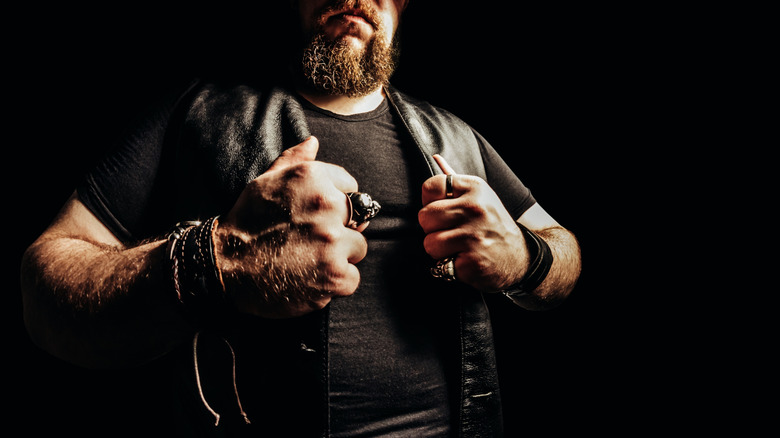What Real-Life Event Inspired Marlon Brando's Motorcycle Movie The Wild One?
IMDb ranks Timothée Chalamet, Austin Butler, and Tom Holland in the top 10 hottest male actors. Back in the '60s, that ranking would have included the likes of Paul Newman, Sean Connery, and Marlon Brando. Audiences couldn't go to the movie theater without seeing Brando's name on something throughout the '50s and '60s. One film of his in particular spoke to America's youth as well as a specific '50s subculture. That was producer Stanley Kramer and director László Benedeck's adaptation of Frank Rooney's 1951 short story "The Cyclists' Raid" into "The Wild One."
"The Wild One" hit theaters in 1953 with Marlon Brando starring as leather-clad motorcycle club leader Johnny Strabler. Brando spoke to the younger generation of the time when his character was asked what he was rebelling against and aptly responded, "Whadda you got?"
In the film, Strabler's club butts heads with a rival club, which wreaks havoc throughout the small town they're in. It's not uncommon for critics to attribute the formation of The Hells Angels, the biggest motorcycle club in California, to "The Wild One," but the first Hells Angels chapter took shape in Fontana, California in 1948, half a decade before Brando's Strabler hit the silver screen.
It wasn't just Rooney's short story that influenced Brando's era-defining motorcycle flick. The real-life Hollister riot of 1947 kicked it all off. So much so that Benedeck filmed "The Wild One" on location, in the very town the riot took place.
The Hollister riot cemented the rebellious biker image
On July 4, 1947, bikers from all across the country converged on the little town of Hollister, California, about 150 miles south of the state capitol, for an Independence Day motorcycle rally. The city had hosted an annual rally but put it on hold during World War II. 1947 was the first year Hollister, with sponsorship from the American Motorcyclist Association, attempted to bring it back. Motorcycles and the culture that formed around them became particularly popular after World War II, especially with veterans, probably a result of the strict, routine lifestyle that comes with being in the military.
Nobody expected any more than 1,000 attendees, but by sundown Hollister was accommodating more than 4,000. The Los Angeles Times in a 2015 story recalled the events of that night, saying, "Members of the Boozefighters gang got drunk, jumped the curb and rode their motorcycles into Johnny's Bar on Hollister's main drag." The Boozefighters might not be one of the big four Outlaw MCs in the U.S. that are frequently arrested for racketeering and drug trafficking, but reports of the event don't make the rally sound like a picnic.
The Times went on to say, "One Boozefighter was arrested for attempting to pour alcohol into a bus radiator. In the end, dozens were arrested and many were injured." Reports like this make the Boozefighters sound like a motorcycle club out of control.
Who are the Boozefighters?
The Boozefighters Motorcycle club was still in its infancy when it attended the Hollister rally, originating in 1946 after the 13 Rebels MC kicked Willie "Wino" Forkner out of their club for his reckless behavior. Forkner, along with others including Fatboy Nelson, Dink Burns, and George Menker got together, found they had similar wants from a motorcycle club, and formed the Boozefighters at the All American Bar in Los Angeles.
While the Boozefighters were the most visible club in Hollister, the club says that none of its original members served time for major crimes, and that it doesn't let today's members participate in illegal activities, emphasizing brotherhood and fun above all else. Some have been known to jokingly call the Boozefighters "A Drinking Club with a Motorcycle Problem." But the club's Chapter 101, in Los Angeles, says: "We are family men, engaged in legitimate business and careers."
When it comes to membership, the chapter adds, it maintains Forkner's principle: "We fought side by side for all Americans to have freedom of choice." So it accepts members from any ethnic, religious, and political background.
Organized as a nonprofit group, the club regularly organizes charity events to raise money for vets, children, and less privileged individuals. "Terminator 2" actor Robert Patrick is a past president of Chapter 101, and former Dokken bassist Sean McNabb is a member. The club appears to be nothing like the Hells Angels or the biggest motorcycle club in Texas.
Events in Hollister might have been exaggerated
When any amount of research is done into motorcycle club culture, it inevitably leads back to the Boozefighters and Hollister. They gave birth to the outlaw biker image. Headlines including "Havoc in Hollister: Motorcyclists Take Over Town; Many Injured" or "Motorcyclist Horde Stages Riotous Meeting in Hollister" littered newspapers in the days that followed the so-called riot. As inspired as writer Frank Rooney, producer Stanley Kramer and director László Benedeck were by such a narrative to root their fiction, it might not have been as bad as the media made it out to be.
A Sacramento, California TV station set out to verify the stories that surrounded that infamous day and sent a reporter to the rally's 70th anniversary in 2017. Dave Westrick, Hollister's police chief in 2017, told KXTV, "I've actually looked at the logbook for 1947, on July 4, and there was one arrest for public intoxication. Really not much going on that day. ... I think the incident was much ado about nothing."



